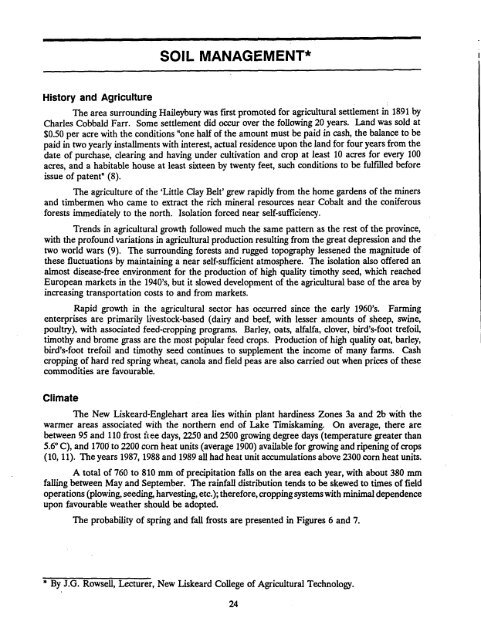® Ontario ontario institute of pedology - Agriculture and Agri-Food ...
® Ontario ontario institute of pedology - Agriculture and Agri-Food ...
® Ontario ontario institute of pedology - Agriculture and Agri-Food ...
Create successful ePaper yourself
Turn your PDF publications into a flip-book with our unique Google optimized e-Paper software.
SOIL MANAGEMENT*History <strong>and</strong> <strong><strong>Agri</strong>culture</strong>The area surrounding Haileybury was first promoted for agricultural settlement in 1891 byCharles Cobbald Farr . Some settlement did occur over the following 20 years . L<strong>and</strong> was sold at$0 .50 per acre with the conditions "one half <strong>of</strong> the amount must be paid in cash, the balance to bepaid in two yearly installments with interest, actual residence upon the l<strong>and</strong> for four years from thedate <strong>of</strong> purchase, clearing <strong>and</strong> having under cultivation <strong>and</strong> crop at least 10 acres for every 100acres, <strong>and</strong> a habitable house at least sixteen by twenty feet, such conditions to be fulfilled beforeissue <strong>of</strong> patent" (8) .The agriculture <strong>of</strong> the `Little Clay Belt' grew rapidly from the home gardens <strong>of</strong> the miners<strong>and</strong> timbermen who came to extract the rich mineral resources near Cobalt <strong>and</strong> the coniferousforests immediately to the north . Isolation forced near self-sufficiency .Trends in agricultural growth followed much the same pattern as the rest <strong>of</strong> the province,with the pr<strong>of</strong>ound variations in agricultural production resulting from the great depression <strong>and</strong> thetwo world wars (9) . The surrounding forests <strong>and</strong> rugged topography lessened the magnitude <strong>of</strong>these fluctuations by maintaining a near self-sufficient atmosphere . The isolation also <strong>of</strong>fered analmost disease-free environment for the production <strong>of</strong> high quality timothy seed, which reachedEuropean markets in the 1940's, but it slowed development <strong>of</strong> the agricultural base <strong>of</strong> the area byincreasing transportation costs to <strong>and</strong> from markets .Rapid growth in the agricultural sector has occurred since the early 1960's. Farmingenterprises are primarily livestock-based (dairy <strong>and</strong> beef, with lesser amounts <strong>of</strong> sheep, swine,poultry), with associated feed-cropping programs . Barley, oats, alfalfa, clover, bird's-foot trefoil,timothy <strong>and</strong> brome grass are the most popular feed crops . Production <strong>of</strong> high quality oat, barley,bird's-foot trefoil <strong>and</strong> timothy seed continues to supplement the income <strong>of</strong> many farms . Cashcropping <strong>of</strong> hard red spring wheat, canola <strong>and</strong> field peas are also carried out when prices <strong>of</strong> thesecommodities are favourable.ClimateThe New Liskeard-Englehart area lies within plant hardiness Zones 3a <strong>and</strong> 2b with thewarmer areas associated with the northern end <strong>of</strong> Lake Timiskaming . On average, there arebetween 95 <strong>and</strong> 110 frost ftee days, 2250 <strong>and</strong> 2500 growing degree days (temperature greater than5 .6° C), <strong>and</strong> 1700' to 2200 corn heat units (average 1900) available for growing <strong>and</strong> ripening <strong>of</strong> crops(10, 11) . The years 1987, 1988 <strong>and</strong> 1989 all had heat unit accumulations above 2300 corn heat units .A total <strong>of</strong> 760 to 810 mm <strong>of</strong> precipitation falls on the area each year, with about 380 mmfalling between May <strong>and</strong> September. The rainfall distribution tends to be skewed to times <strong>of</strong> fieldoperations (plowing, seeding, harvesting, etc .) ; therefore, cropping systemswith minimal dependenceupon favourable weather should be adopted .The probability <strong>of</strong> spring <strong>and</strong> fall frosts are presented in Figures 6 <strong>and</strong> 7 .* By J.G . Rowsell, Lecturer, New Liskeard College <strong>of</strong> <strong>Agri</strong>cultural Technology .24
















